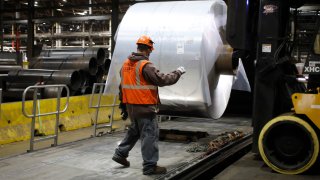
- Producer prices at the wholesale level rose 11% over the past year and 0.5% in April alone, the Bureau of Labor Statistics reported Thursday.
- Weekly jobless claims were little changed, but continuing claims fell to their lowest level since January 1970.
Prices at the wholesale level accelerated further in April, part of a broader inflation problem persisting through the U.S. economy, the Bureau of Labor Statistics reported Thursday.
The producer price index, which tracks how much manufacturers get for products at their initial sale, rose 0.5% on the month and 11% from a year ago, a decrease from the record 11.5% in March that was revised upward 0.3 percentage points.
Get DFW local news, weather forecasts and entertainment stories to your inbox. Sign up for NBC DFW newsletters.
Excluding food, energy and trade services, core PPI rose 0.6% in April and 6.9% from a year ago, the latter a decline from 7.1% last month.
Both monthly increases were exactly in line with Dow Jones estimates. Headline PPI rose 1.6% in March while core was up 0.9%.
Those numbers came the day after the BLS reported that consumer prices for goods and services in the marketplace rose 8.3% from a year ago, down from 8.5% in March but still indicative of the worst inflation the U.S. has seen since the early 1980s.
Money Report
A separate economic report Thursday showed that jobless claims totaled 203,000 for the week ending May 7, an increase of 1,000 from the previous period. That was above the Dow Jones estimate for 194,000.
Continuing claims fell, however, dropping by 44,000 to 1.343 million, the lowest level since Jan. 3, 1970.
While the news has been largely good for the jobs market, it is inflation that is bedeviling policymakers the most and threatening to thwart the expansion. President Joe Biden this week has spoken multiple times about the raging price increases during his administration and set forth several proposals to tackle the problem.
Gas and groceries have been responsible for much of the inflation surge, with indexes tracking the two sectors up a respective 1.7% and 1.5% in April, according to the PPI data. Auto prices, particularly for used vehicles, also have been a major inflation component, and the PPI index for motor vehicles and equipment increased 0.8% on the month.
The gasoline index fell 3.2%, during April when prices at the pump eased. However, that trend has since reversed, with gas prices back around record highs.
While Biden has pledged action at the legislative level, he also has pointed out the Federal Reserve's role. The Fed last week approved a half percentage point increase in its benchmark interest rate, the second increase this year with more expected to come.
"While inflation is likely past the peak in the United States, it has gained considerable momentum over the last two years, and is likely to close 2022 well above the Federal Reserve's 2% objective," said Bill Adams, chief economist for Comerica Bank. "The Fed will want to see clearer evidence that inflation is cooling and higher interest rates are slowing demand before they start thinking about the endpoint of the current rate hike cycle."
Market pricing Thursday morning indicated a likely additional half-point hike in June and the year ending with the fed funds rate around 2.5%-3% from its current target range of 0.75-1%, according to a CME Group futures tracker.






